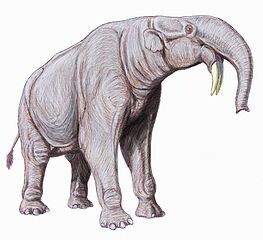4 Stupid Real-World Origins Of Mythical Monsters

As the weather gets colder and the mist rolls in, we just naturally suspect that it's concealing giant, man-eating insects. Inventing monsters is just what we do. Take comfort, then, that a lot of monsters myths began with something really, really stupid ...
Cyclops Were Probably Schnozzy Elephants
A surprising number of monster myths rose from ancient dumb-dumbs happening upon fossils and not knowing what they were looking at. For example, what people thought were dragon bones were probably just dinosaurs, proving that reality can be arguably much cooler than anything you can imagine. There's not a lot of preschoolers who like to dress up as dragons.
Don't Miss
Possibly the silliest osteological misinterpretation, however, either gave us the cyclops myth or provided a bunch of believers with "See? I told you, Demetrius" material. Scientists believe it all started with the prehistoric skulls of a long-extinct elephant-ish boy called Deinotherium giganteum, which translates loosely and hilariously to "really huge terrible beast," and even looking at their skeletons, it's not hard to see why.

Let's try to be charitable here and assume the Ancient Greeks -- who probably encountered these fossils, which have been found in the area -- overlooked those massive tusks for some understandable reason. If you're just looking at that huge hole in the center of the skull and somehow imagining a humanoid body, you can see how they made the "cyclops" leap, but shame on you for your bipedalist bias. In reality, the hole accommodated their truly gargantuan conks.

Too often, that's just how it goes: A bunch of jackasses who don't know how uteruses work find a bunch of bones, get on their bs, and bam, a monster is born.
Ireland is a magical land full of weird fog, moving statues, and rugby fans, so they've had to explain away some pretty bizarre crap to themselves. One of the ways they did that was the legend of the banshee, a ghost-like creature who flies around shrieking and plays goth rock. While most ghosts are content with general spookiness, banshees are specifically omens of death who show up to scream at you when you or someone near to you is about to die. Yeah, they're dicks. They're also probably owls.
Specifically, barn owls, who are so unpleasant to listen to that they're also known as "screech owls" because Ireland can't just have normal owls, either. Instead of hooting softly and vaguely wisely, barn owls scream like they just stubbed their toe on a lemon full of knives made out of LEGO. Seriously, listen to these drama queens.
Barn owls also have a feather pattern that has evolved to make them look like formless white blurs in flight, and they like to nest in old abandoned buildings and hunt in the dead of night in shadowy open fields. Basically, if you're in a position to encounter a barn owl, things aren't looking great for you anyway, which could be why they became associated with death. Either that or people took drastic measures to stop hearing that sound. They are real obnoxious.
Will-o'-the-wisp Are Swamp Farts
It's never a great idea to go wandering around Europe's marshlands alone at night, but if you just gotta have your bog walk, you might be warned about the will-o'-the-wisp, malevolent spirits who take the form of ghostly blue lights that appear above swamps to entrance passersby and lead them to their doom. Yes, like in Brave, except instead of luring you to a morally ambiguous witch's hut, you'll probably just fall into the swamp and drown.
Even back in the 18th century, though, people suspected those li'l swamp fairies weren't anything supernatural. Shortly after discovering methane in an Italian lake in 1776, Alessandro Volta suggested the ghost lights were the result of lightning mixing with such gases, and aside from the wild notion that lightning was just hanging around European swamps, his theory remains the prevailing explanation. Highly flammable gas rises up from dead fish and plants languishing in the bog, combusts in mid-air, and then extinguishes with the movement of air, which is why they tend to disappear when people approach them. As for their entrancing properties, well, people back then were obsessed with pointy shoes. It didn't take much to entrance them.
Lots of Sea Monsters Were Probably Whale Dongs
A lot of sea monster legends can be explained by exaggerated sightings of perfectly ordinary ocean dwellers -- the kraken was probably an already unacceptably large giant squid, mermaids were probably manatees viewed through the lens of half-starved and full-horny sailors, etc. But there aren't a lot of known creatures that can account for descriptions of sea serpents. An eel-like body with enough power to thrust itself high above the water? That's no whale ecologist Charles Paxton had ever heard of. But there was something that, he realized, matched those descriptions: a whale's hoodilly.
"Many of the large baleen whales have long, snake-like penises," he wrote in a 2005 paper. "If the animal did indeed fall on its back, then its ventral surface would have been uppermost and, if the whale was aroused, the usually retracted penis would have been visible." It turns out, if you're pretty far away and getting most of your hydration via rum, that looks an awful lot like a serpent's head or tail.
In fact, if one frisky cetacean was prowling for some fin in one area and another was doing the same some distance away, their respective wang-doodles could be mistaken for the head and tail of one creature, giving the impression of a truly imposing dong-beast. This likely accounts for sightings of monsters "longer than our whole ship" or, tellingly, in the middle of a pod of whales "frantic with excitement." The next time you hear something go bump in the night or just get a strange feeling you're not alone, take heart: It could just be someone's dick.
Top image: Wikimedia Commons